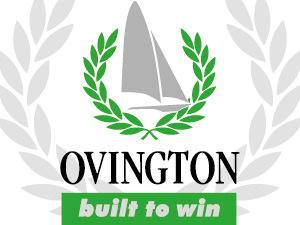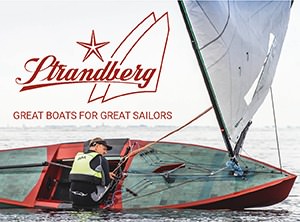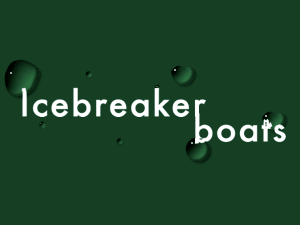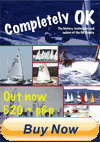You are here: okdia.org > association > history > axel damgaard olsen
History
Memories about Axel Damgaard Olsen, the OK co-designer
by Gerald Elfendahl 1998Axel was an elfen fellow with a twinkle in his eye like Santa Claus. He had a ready smile. You liked him immediately.
He was a tremendous teacher, though he would never want to wear that formal label. He just loved to share all he new and all he learned. He was my sailing mentor when I was in my early twenties.
He moved to Seattle with Gudrun from Denmark in the late 1950's. I was graduating from high school then and went away to college where I discovered and fell in love with both my wife and sailing. I was married to each when I returned to the Seattle area.
It took me another year to save enough money to buy a sailboat and there was no question what kind it would be. It was one that was inexpensive, high performance, alive, and fun. Axel and his many new friends in Seattle were the most fun gang of sailors around with a new type boat-- the OK Dinghy!
Seattle newspapers often carried pictures of these crazy folks planing OK's across the waters, leaning with backs arched out over the waves and flying spray. Freezing weather or summer sun, it didn't matter. These fanatics were sailing the lakes and inland seas here and often capsizing with little concern. Some wore wetsuits to protect from hypothermia. They were completely self-reliant on the water. They were having fun learning by racing together everywhere, anywhere.
This was for me. For $300, I got a kit with sail "US 11" and was in the water in no time.
I was young, quick and agile, though heavier than most. My Elvstrom sail was beautiful and my boat light. When we started racing with Axel and his friends, it wasn't long before we were crossing tacks with Axel himself.
Long weather legs to windward were always a challenge, especially for the elder folks in the fleet. What I lacked in finesse, I made up for in weight and endurance when it blew. When you sailed close to Axel, who was maybe in his forties at the time, it was a social event. He loved to talk.
Sometimes it was just friendly chatter. Other times, he told jokes. You might have to wait for the punch line until the next time you crossed tacks. Part of my competitive spirit then felt that Axel was telling stories to distract me while racing. I used to practice sailing my OK blindfolded just so I could sail along with Axel and not fall behind. His stories and sailing advise freely rendered were prized by me. They were no distractions. They were why we sailed.
After racing, it was even better. Usually, we'd all have a beer somewhere and retell every manuever, wind shift, tactical decision and weight, balance, trim and sail adjustment of the day's racing. You always learned something new.
The most important lesson, one that went way beyond the race course, may have been, as anyone who has sailed an OK can attest, that you always had to be, as Axel said with a smile and a residual Danish accent, "a-yust'-able."
Axel had grown out of one of the world's finest sailing communities in Denmark. Paul Elvstrom, the then four-time Olympic medalist, was a close friend who occasionally visited Axel in Seattle. There were fine smallboat sailing centers in North America-- Vancouver, California, Wisconsin and "back East" and elsewhere on the planet, too-- Austrailia, New Zealand, England, France, Sweden-- but Elvstrom seemed to be the best and most creative, he and his Danish friends.
Axel had earlier gone to sea on a freighter and once made port at Clearwater, Florida. A social service group there called "The Optimist Club" sponsored youth programs centered around soap box derbies, until a youngster died one day in a collision with a car. They traded soap box racing for sailboat racing and put their kids on the water in small, flat-bottomed, sprit-rigged pram-bowed dinghies. They were so easy to build that they seemed to breed on their own. Plans were available free from WOMAN'S DAY Magazine. Anybody could build one.
Axel took the plans to Europe and within months there were literally thousands on the water. Axel said it was more than a sailing boom, it was a social revolution of sorts. Suddenly, the water, and "yachting" were accessible to everyone. You didn't have to own the beach to have a boat and enjoy the freedom of the seas, the wind and the waves. The Optimist Pram's popularity may be one of Axel's greatest legacies.
About 1949, Axel went to his friend and naval architect, Knut Olsen, and asked him to draw up plans for a new boat. Axel had designed it intuitively, in his mind's eye, in his gut. He knew what he wanted. It had to be just so. It was time to get his feelings, his vision, refined on paper.
His boat would offer sailor's a challenge, a chance to really feel the variables of sail. It would be inexpensive. Plywood and a new material, Fiberglas, would simplify construction and keep weight down. It would be safe, with built-in buoyancy compartments. It would have a simple, unstayed, cat rig. The sail would evolve from the mainsail of the region's popular Pirate Class sloop-- their sails were easy to obtain.
Knut drew up the plans for Axel's one-person, four-meter long, hard-chined craft and they named it the "OK" dinghy for the universal expression popular in post-WW II Europe. It was a very "okay" dinghy!
The tight specifications of some one-design classes were not what Axel had in mind with the OK. He'd learned from the Optimist. The goal was not absolutely identical boats, but lots of people having fun together on the water.
Tolerances were close, but not too rigid. There was latitude for amateur builders. There was room for experienced sailors and builders to experiment and test design theories. The OK was small enough, yet responsive enough, that folks could learn without alot of money invested. The OK evolved.
Axel organized many boat building projects near Seattle, some using another new material, glass reinforced plastic-- fiberglass. While the OK took off in Europe, fleets begin popping up in America, too. Axel always encouraged builders to keep it simple and keep it fun.
"Don't worry about all the gadgets," he'd say. "That will all come soon enough. Just get on the water!"
He always carried a spool of twine which he reminded, "was as good as any metal shackles or fasteners."
Folks made their own masts, laminating them from beautiful local kiln-dried spruce. I once asked Axel why he never conceived of a gooseneck fitting for the OK, like other boats. "It's an old design principle," he replied, one hand on the mast base. "There is nothing cheaper than a hole! The boom just goes through the mast. Simple."
Boom vangs evolved, too, in time. But, in the beginning, there was nothing simpler than the wedge.
"Just get on the water. There's a race coming up soon!"
Axel was a real promoter, for sure. He'd call his friends, all the OK fleets, and say the same thing: "There is a regatta on the bay on Saturday. Thirty boats are coming. Here's the details." It didn't matter if you were the first person called, it was always, "Thirty boats are coming." And there were always thirty boats ... or more. You always felt a part of something special.
Axel was always experimenting. He made his own cleats, moved fittings everywhere. They might be better at a different angle, a different location. Everything was fair game. We spent one winter studying moth wings!
Axel said, "Early research on low speed airfoils used seagull wings, but I think the airspeed of an OK's sail is closer to that of a moth's wing."
We captured moths, found moth photos, looked at their wings beneath microscopes, studied hair-like filaments attached to nerve ends on the wings' trailing edges that seemed to control moth flight, laminar flow and stall angles. We traced wing shapes onto graph paper. Soon Axel started to build a new mast.
Axel and Gudrun lived not far from the western park-lined shores of Lake Washington, a mile north from Seattle's famous floating bridge. Although they lived in a series of homes, Axel's shops in each were similar. They were in the basement-- with very low ceilings!
Axel's shops were not private worlds. He welcomed everyone to come in. But they were not easy worlds to enter.
Olsen was short, even wearing the thick, hand-carved, boat-like wooden shoes or Danish clogs. He liked to wear them working there. While Axel would busy himself, clogging freely about the place, others moved cautiously. You only had to have your bell rung once by an over head beam before you became a hunchback.
One day, Axel had carefully marked an enlarged curve of the moth wing on a work surface and laminated strips of spruce to the mast replicating the curve. His new mast would be so successful in light air that in the largest regional race against all classes, it easily out ghosted everyone.
Axel's spirit of experimentation was contagious. Some couldn't wait to sail in a light snow fall that enabled us to see and even photograph the flow of air around around our sails.
When summer came and the glow-in-the-dark, bioluminescent Noctiluca scintilans bloomed in the warmer Puget Sound waters, our island OK fleet would have a contest. Everyone would design and build their best rudder. We'd all bring them to the dock after dark. Then we'd take turns running up and down the dock, dragging our rudders in the water. The rudder design that disturbed the dinoflagelate least, made the least amount of light. It was easy to tell the winner. The design quickly was found on every OK transom.
An International OK Association formed and the U.S. organized a National Association, too. From neighborhood and fleet racing evolved national and world championships. The little OKs were easily car-topped or trailered.
OK's evolved differently from place to place. The light air and waves of NW America evolved boats with concave bows and lots of rocker. Elsewhere, racing in heavier winds put a premium on getting up onto a plane. "First up, first gone!" was the motto. Hulls there evolved with with full convex bows that generated lift and long straight keels.
Axel loved other boats and water sports, too. He loved river kayaking, building his own, and playfully falling and dancing through rapids and cascades. He also donned skis to fly across frozen water, down mogels and snow slopes.
Once, Axel challenged himself to design the most sailboat that could be built from two 4' x 8' sheets of 1/4 inch plywood. The result was a two-meter composite-built pram called the "Mamu". It had an 8' dowel for a mast, a 3/4 inch dowel for a sprit, and a bed sheet for a sail. It weighed 27 pounds and cost $27-- $1/lb.! You simply cut out the plywood, notched it together, taped the seams with fibreglass, added gunnel and paint and you were in the water. Axel joined friends at a local Small Sailboat Show and demonstrated building a Mamu in two hours. One-hundred folks on one Puget Sound island got their start sailing the Mamu.
He spent several years building FANTASIA., a 30 to 40 foot, one-ton IOR class sailboat, designed with Elvstrom's help. It had rainbow stripes down the sides and a functional interior that reminded me that he'd learned something from designing interiors for Boeing jetliners. FANTASIA was rigged similar to his OK. While younger men clung to pedestals and ship's wheels, Axel charged FANTASIA through inland and offshore seas with tiller and hiking stick- his ultimate dinghy. Axel was ageless.
The last time I visited him, after years of cruising and raising a family, he took me into that sawdust filled basement. I hunched over and waited while he clogged to the far wall.
He picked up a sculpted, blue, fibreglass sailboard and enthused, "Well, here it is. This is the future. Everyone will soon have one of these sailboards like a pair of skis. This is my third one. I nearly won the all-comers event with it like we did with the moth wing!"
Untold numbers of sailors learned and polished their art and skills in an OK. Some of the world's best. And the King of Thailand, with the world to choose from, still enjoys his OK, we hear, once even sailing on a 50 kilometer (30 mile) passage. Several young-at-heart sailors have cruised OK's through the Pacific NW's inland seas. And thousands of people of all ages have built friendships that have lasted their lifetimes around a superb little boat named "OK". The lucky ones had the chance to know Axel Damgaard Olsen and remember his smile.
Post script:
Axel died in a car accident. He was an innocent passenger being driven home after a day of sailing. The car that killed him was driven by a criminal being pursued at very high speed by police through city streets. Some countries have laws preventing high speed chases. Ours still allow them. But should they?
| To Top Of Page |










